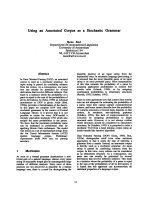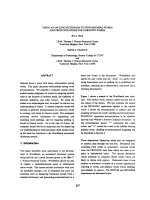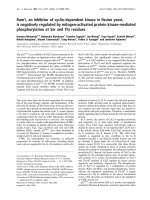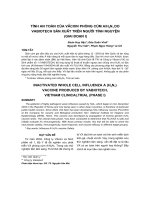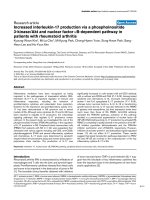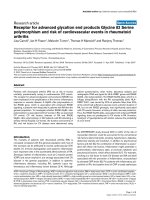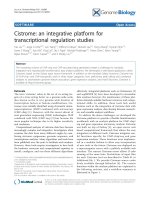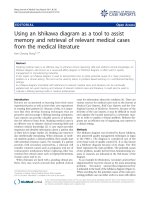Báo cáo y học: " Using an Ishikawa diagram as a tool to assist memory and retrieval of relevant medical cases from the medical literature" ppt
Bạn đang xem bản rút gọn của tài liệu. Xem và tải ngay bản đầy đủ của tài liệu tại đây (316.87 KB, 3 trang )
EDI T O R I A L Open Access
Using an Ishikawa diagram as a tool to assist
memory and retrieval of relevant medical cases
from the medical literature
Kam Cheong Wong
1,2,3,4
Abstract
Studying medical cases is an effective way to enhance clinical reasoning skills and reinforce clinical knowledge. An
Ishikawa diagram, also known as a cause-and-effect diagram or fishbone diagram, is often used in quality
management in manufacturing industries.
In this report, an Ishikawa diagram is used to demonstrate how to relate potential causes of a major presenting
problem in a clinical setting. This tool can be used by teams in problem-based learning or in self-directed learning
settings.
An Ishikawa diagram annotated with references to relevant medical cases and literature can be continually
updated and can assist memory and retrieval of relevant medical cases and literature. It could also be used to
cultivate a lifelong learning habit in medical professionals.
Introduction
Doctors are accustomed to learning from their more
experienced peers as well as from their own experiences
in treating their patients [1]. Because of this, it is impor-
tant that they develop learning techniques that are
proactive and encourage a lifelong learning orientation.
Case reports can provide valuable sources of infor ma-
tion for others to learn from. Studying medical cases is
an effective way to enhance clinical reasoning skills and
reinforce clinical knowledge [2]. A case report provides
important and detailed information about a patient that
is often lost in larger studies [3]. Reading case reports is
also intellectually stimulating. When clinician s or medi-
cal students analyze a clinical problem, they usually start
with potential common causes. For example, if a patient
presents with secondary amenorrhea, a clinician will
consider common causes such as pregnancy and use of
contraceptive medications before exploring other less
common but critical causes such as hyperprolactinemia,
ovarian cancer and so on.
When clinicians are faced with a puzzling clinical pro-
blem, they may search journals that publish clinical
cases for information about the condition [4]. There are
various sources for medical cases such as the Journal of
Medical Case Reports, BMJ Case Reports and the New
England Journal of Medicine. However, because of the
diversity of the case reports, it may be difficult to recall
and organize the located material in a systematic man-
ner in order to explain a clinical problem. Ishikawa dia-
grams are an efficient way of organizing case reports in
a clinical setting.
Methods
The Ishikawa diagram was invented by Kaoru Ishik awa,
who pioneered quality management techniques in Japan
in the 1960 s. The diagram is considered one of the
seven basic tools of quality control [5]. It is also known
as a fishbone diagram because of its shape. The ‘fish
head’ represents the main problem. The potential causes
of the p roblem, usually derive d from brainstorming ses-
sions or re search, are indicated in the ‘fish bones’ of the
diagram.
As an example for illustration, ‘secondary amenorrhea/
oligomenorrhea’ hasbeenchosenasthemainpresenting
problem. ‘ Secondary amenorrhea/oligomenorrhea’
is indicated in the head of the Ishikawa diagram (Figure 1).
When searching for the potential caus es of the main pre-
senting problem, one can either work in a team with others
Correspondence:
1
University of Sydney, Sydney Medical School, NSW, Australia
Full list of author information is available at the end of the article
Wong Journal of Medical Case Reports 2011, 5:120
/>JOURNAL OF MEDICAL
CASE REPORTS
© 2011 Wong; licensee BioMed Central Ltd. This is an Open Access article distributed under the terms of the Creative Commons
Attribution License ( which permits unrestricted use, distribution, and reproduction in
any medium, provided the original work is properly cited.
or in a self-directed learning setting. Clinicians would
conduct brainstorming sessio ns and search the relevant
journals to find potent ial causes for sec ondary ameno r-
rhea/oligomenorrhea, listing them on a whiteboard or
flipchart. The list would then be reviewed to extract rele-
vant causes in the context of the main presenting pro-
blem. These causes would then be organized in the ‘fish
bones’ of an Ishikawa diagram (Figure 1). There is no
limit to the number of ‘fish bones’ in the diagram. Each
‘fish bone’ can be subdivided into smaller ‘bones’ if neces-
sary to show the relationship of all potential causes to the
presenting problem. For example, ‘chemotherapy and
radiotherapy’ are indicated in the branch of the ‘fishbone’
that shows the cause of ovarian failure, a potential cause
for secon dary a menorrhea/oligomenorrhea (Figure 1).
The cited references for the relevant case reports and lit-
eratures are also indic ated in the Ishikawa diagram so
that readers can retrieve the case reports and relevant lit-
eratures e asily.
The potential causes for secondary amenorrhea/oligo-
menorrhea have been identified and categorized in four
groups related to ‘women’s reproductive systems ’, ‘other
systems in the body’, ‘psychosocial’,and‘miscellaneous,
for example drugs’ . The causes include pregnancy [6],
polycystic ovarian syndrome [6], amenorrhea after oral
contraceptive/depot medroxyprogesterone treatment [7],
eating disorder (for example,anorexianervosa)[7],
premature ovarian failure [8], excessive physical exercise
[9,10], excessive stress [11], prolo nged use of
ant i-psychotic [7,12], hypothyroidism [13], hyperprolac-
tinemia [14], ovarian cancer [15], and Cushing syn-
drome [16]. Thus the Ishikawa diagram illustrates and
summarizes the potential causes for secondary amenor-
rhea/oligomenorrhea (Figure 1).
Conclusions
Rare but critical cases should be studied and included in
an Ishikawa diagram to remind clinicians of relevant
information during their clinical reasoning processes.
For example, the Journal of Medical Case Reports has
published the case of a 22-year-old lactating woman
who presented with four months of amenorrhea asso-
ciated with signs of virilization. The patient was diag-
nosed as having an androgen secreting steroid cell
Secondary
Amenorrhea/
Oligomenorrhea
Woman
reproductive
system
Psycho-social
Other systems in
the body
Miscellaneous
Post oral contraceptive/ depot
medroxyprogesterone [7]
Polycystic ovary
s
yndrome [6]
Pregnant [6]
Cushing syndrome [16]
Hypothyroidism [13]
Prolonged use of
drugs e.g.
antipsychotic [7, 12]
Eating disorder (e.g.
Anorexia nervosa) [7]
Excessive stress [11]
Ovarian failure
Hyperprolactinaemia [14]
Excessive physical
exercise [9, 10]
Chemo & radiotherapy [8]
Ovarian tumor [15]
Figure 1 Ishikawa diagram. ‘Woman’ s reproductive system’ includes causes such as pregnancy, polycystic ovary syndrome, ovarian tumor, and
ovarian failure. ‘Other systems in the body’ includes causes such as hypothyroidism, Cushing syndrome, hyperprolactinemia, and eating
disorders. ‘Psychosocial’ includes causes such as excessive stress and excessive physical exercise. ‘Miscellaneous’ includes causes such as
prolonged use of drugs, for example anti-psychotics, and after oral contraceptive/depot medroxyprogesterone treatment.
Wong Journal of Medical Case Reports 2011, 5:120
/>Page 2 of 3
tumor of the ovary [15]. In addition, BMJ Case Reports
has published a case demonstrating the relat ionship
between hypothyroidism and secondary amenorrhea.
Important learning points are highlighted: serum thyroid
stimulating hormone (TSH) should be measured in
every adolescent with menstrual irregularities, multicys-
tic ovaries as a presenting manifestation of juvenile
hypothyroidism is a rare occurrence and represents
advanced disease, and appropriate diagnosis and
levothyroxine replacement therapy is effective and it can
prevent inadvertent surgery [13].
Furthermore, the reader should appraise the published
case to assess the credibility of the information and
should look for updated info rmationinthefuture.For
example, if the readers are not fully convin ced of the
explanation for the pathophysiology of ‘ specificity spill
over’ phenomenon that may contribute to multicystic
ovaries [13,17], he or she should search for more infor-
mation about it and look out for future publications on
this topic. Information gathered from other sources can
be included in the diagram as well, such as the paper
published in the British Journal of Obstetrics and Gynae-
cology, which has substa ntiated information about ovar-
ian cancers and amenorrhea [8]. In this way, continually
organizing and updating information on an Ishikawa
diagram can cultivate lifelong learning habits in medical
professionals.
Medical educators can also apply Ishikawa diagrams to
facilitate problem-based learning when teac hing medical
students and junior doctors. Starting with a clinical
vignette, facilitators can help medical students and
junior doctors to identify the main presenting problem
of a pati ent, conduct brainstorming sessions and sea rch
in the literature to find the potential causes, then cate-
gorize these causes in an Ishikawa diagram. The Ishi-
kawa diagram can then be kept by individual learners
for continual updating when they acquire new or rele-
vant information. In short, an Ishikawa diagram can
assist memory and the retrieval of relevant medical case
reports and literatures.
Acknowledgements
I would like to thank the Journal of Medical Case Reports and BMJ Case
Reports for providing access to the case reports, and the peer reviewers and
Dr Myra Dunn (Education Officer at Beyond Medical Education, Australia) for
their comments and suggestions. The author’s Academic Registrar position
was funded by General Practice Education & Training (GPET), Canberra,
Australia.
Author details
1
University of Sydney, Sydney Medical School, NSW, Australia.
2
University of
Western Sydney, School of Medicine, NSW, Australia.
3
Beyond Medical
Education, NSW/VIC, Australia.
4
George Street Medical Practice, Bathurst,
NSW, Australia.
Competing interests
The author declares that he has no competing interests.
Received: 16 November 2010 Accepted: 29 March 2011
Published: 29 March 2011
References
1. Jenicek M: Clinical case reporting in evidence-based medicine. 2 edition.
London: Arnold; 2001.
2. Vandenbroucke JP: In defense of case reports and case series. Ann Intern
Med 2001, 134:330-334.
3. Kidd M, Hubbard C: Introducing journal of medical case reports. J Med
Case Reports 2007, 1:1.
4. Wong G: Case reports: a helping hand to generalists. J Med Case Reports
2008, 2:311.
5. Ishikawa K, Loftus JH, (Eds): Introduction to quality control Tokyo, Japan: 3A
Corporation; 1990.
6. Golden NH, Carlson JL: The pathophysiology of amenorrhea in the
adolescent. Ann N Y Acad Sci 2008, 1135:163-178.
7. Gordon CM: Functional hypothalamic amenorrhea. New Engl J Med 2010,
363:365-371.
8. Schmidt KT, Larsen EC, Andersen CY, Andersen AN: Risk of ovarian failure
and fertility preserving methods in girls and adolescents with a
malignant disease. BJOG 2010, 117:163-174.
9. Meczekalski B, Podfigurna-Stopa A, Warenik-Szymankiewicz A, Genazzani AR:
Functional hypothalamic amenorrhea: current view on neuroendocrine
aberrations. Gynecol Endocrinol 2008, 24:4-11.
10. Nattiv A, Loucks AB, Manore MM, Sanborn CF, Sundgot-Borgen J,
Warren MP: American College of Sports Medicine position stand. The
female athlete triad. Med Sci Sports Exerc 2007, 39:1867-1882.
11. Liu JH: Hypothalamic amenorrhea: clinical perspectives, pathophysiology,
and management. Am J Obstet Gynecol 1990, 163:1732-1736.
12. Perkins RB, Hall JE, Martin KA: Neuroendocrine abnormalities in
hypothalamic amenorrhea: spectrum, stability, and response to
neurotransmitter modulation. J Clin Endocrinol Metab 1999, 84:1905-1911.
13. Bhansali A, Shanmugasundar G, Walia R, Santosh R, Dutta P: Acute
abdomen and hypothyroidism. BMJ Case Reports 2009.
14. Srikantha M, Butterworth R: Pharmacological hyperprolactinaemia. BMJ
Case Reports 2009.
15. Haji AG, Sharma S, Babu M, Vijaykumar D, Chitrathara K: Androgen
secreting steroid cell tumor of the ovary in a young lactating women
with acute onset of severe hyperandrogenism: a case report and review
of literature. J Med Case Reports 2007, 1:182.
16. Lado-Abeal J, Rodriguez-Arnao J, Newell-Price JD, Perry LA, Grossman AB,
Besser GM, Trainer PJ: Menstrual abnormalities in women with cushing’s
disease are correlated with hypercortisolemia rather than raised
circulating androgen levels. J Clin Endocrinol Metab 1998, 83:3083-3088.
17. Yoshimura M, Hershman J: Thyrotropic action of human chorionic
gonadotropic. Thyroid 1995, 5:425-434.
doi:10.1186/1752-1947-5-120
Cite this article as: Wong: Using an Ishikawa diagram as a tool to assist
memory and retrieval of relevant medical cases from the medical
literature. Journal of Medical Case Reports 2011 5:120.
Submit your next manuscript to BioMed Central
and take full advantage of:
• Convenient online submission
• Thorough peer review
• No space constraints or color figure charges
• Immediate publication on acceptance
• Inclusion in PubMed, CAS, Scopus and Google Scholar
• Research which is freely available for redistribution
Submit your manuscript at
www.biomedcentral.com/submit
Wong Journal of Medical Case Reports 2011, 5:120
/>Page 3 of 3
